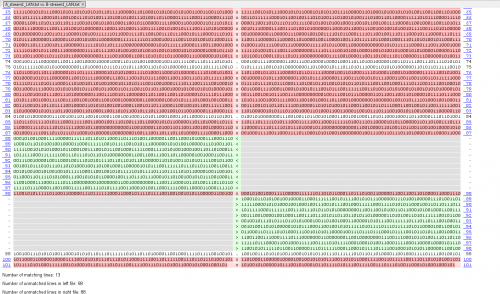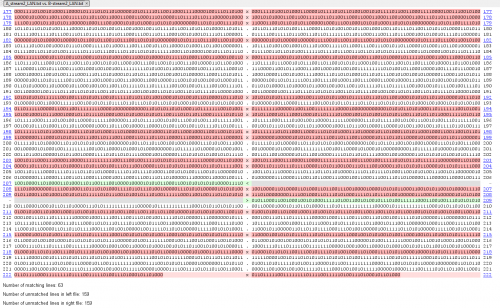Timing Based Encryption: Test Case 4
Alice and Bob on same network[edit]
The physical layer security program was run by two computers on the same network. The benefits of this test was the fact that the bit stream was generated extremely quickly due to the fact that the round trip times are so low on a LAN network. Additionally, the lack of noise on a LAN network means that the sender/recipient bit streams should be very well synchronised, and as we previously proved in the second Timing Based Encryption Test, Eve does not gain anything from all of the computers being on a LAN network. Thus, if the results show that the streams are kept synchronised very well, this could be the most secure method of communication. However, if we consider the physical scenario of two computers on a LAN network, it could be just as practical to physically hand the person you are communicating with the message. Nonetheless, the situation was still tested.
Test 1[edit]

We see that for a reasonable long bit stream generated of 8000 length, the bit error rate was only 3%. This is extremely low and backs up our initial hypothesis that the bit streams will be well synchronised.
Test 2[edit]

A second test run further confirms our initial hypothesis, as it shows us that for an even longer test run which made a bit stream of length 18000, the bit error rate is even lower: being 2.15%. These results suggest that on a LAN network the longer the bit stream is, the more accurate it will be.
Summary of Results[edit]
The results show that in a 'noisy' channel, the bit error rate is actually better after reconciliation. This can be attributed to the extra randomness which comes from this additional noise, which actually suits our protocol nicely. It is important to note that even in a 'steady' channel, the results are still extremely good - and in every case the two bit streams stay in sync very well.
See also[edit]
- Timing-based key agreement
- Timing Based Encryption: Test Case 1
- Timing Based Encryption: Test Case 2
- Timing Based Encryption: Test Case 3
- Timing Based Encryption: Test Case 4
- Timing Based Encryption: Test Case 5
- Geometric Algebra
- CLUViz Geometric Algebra Animation Software
- Secure communications without key exchange (main page)
- Secure communications without key exchange? 2013 weekly progress
- Proposal Seminar 2013: Secure communications without key exchange?
- Final Seminar 2013: Secure communications without key exchange?
- Semester A Progress Report 2013 - Secure communications without key exchange?
- Semester B Final Report 2013 - Secure communications without key exchange? 2013
- YouTube Videos

